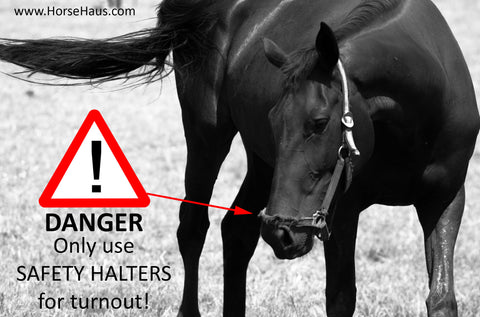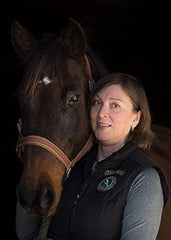I usually like to recount happy events and leave disappointments - after learning from them - in the past. In this case, I'd like to share an upsetting experience with you... One that taught me that Safety Halters can be real life savers.
A few years back, I took on a rehab horse with the ill-fated barn name "Jimmy Dean" (like the sausage...). All luck had run out for this well-bred 4-year-old, who had lost all faith in the human race and had the 'panic' button as his go-to response. [His name is 'Yogi' now and he has found a new career as a therapy horse!]
Tying the horse was one of the challenges that I overcame with lots of patience and bailing twine as an 'easy break' link. After a few months of success in various rehab areas, I became overly optimistic and tied good "Jimmy Dean" to a hitching post while waiting for the farrier - without the bailing twine link!
Long story short: Jimmy Dean panicked, reared, got his legs over the hitching post, his hind legs slipped under his body, he slammed on his hind end and injured himself. A water melon sized hematoma was the dangerous and costly result.
If I could rewrite this story (like the old video tapes, rewind and re-record...), I would give Jimmy Dean a Safety Halter (like the KavalLastic in the image on the right).  This would have saved a lot of grief, injury, and money.
This would have saved a lot of grief, injury, and money.
For convenience, many horse owners like to leave a halter on their horse during turnout. A potentially dangerous practice! Horses can get their feet caught in the halter or get hung-up on fence or other elements in their enviro nment. This often has a sad and deadly ending.
nment. This often has a sad and deadly ending.
Hauling your horse to a show or picking up a new horse? During transport, we are not in the same space as our horse and cannot monitor, correct, or help our horse in dangerous situations. Injuries sustained by pulling back on the halter repeatedly are often micro-injuries in the cervical vertebrae or subluxations. Another very avoidable scenario.
Here some things you can do to keep your horse safe:
- Never tie a horse on a rope halter - unless you attach a break-away link.
- Never keep your horse's halter on during turnout - unless you use a Safety Halter.
- Attach break-away links to your cross-ties. (There are too many unbreakable cross ties - many with chains - out there!!!) If you are in a crunch, use a bailing twine! Leather thongs are great for a more attractive look.
- During transport or at shows, ALWAYS use a Safety Halter. This way you are ready for any kind of situation.
I love our KavalLastic Safety Halter (Made in Germany) with soft, removable padding on nose and crown piece. It is fully washable and the stainless steel hardware is sure to last for years. A small investment in your horse's safety that can save a lot of heart-ache and grief!
Questions? Comments? Please leave a comment below.
Enjoy your horse!

Stefanie Reinhold

